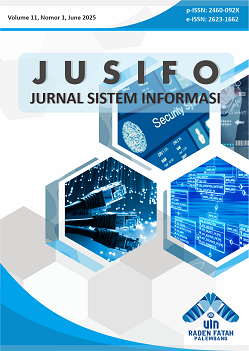Forecasting and Raw Material Planning in Traditional Songkok Production Using ARIMA and Simple Exponential Smoothing
Main Article Content
Abstract
This study investigates the applicability of time series forecasting models—Autoregressive Integrated Moving Average (ARIMA) and Simple Exponential Smoothing (SES)—for optimizing raw material planning in traditional songkok production. Utilizing monthly production data from a small-scale manufacturer in East Java, Indonesia (July 2020–August 2024), the ARIMA(1,1,1) model demonstrated superior forecasting performance, particularly under weak and irregular seasonality. Compared to SES, ARIMA yielded lower MAE, MSE, and MAPE values, enabling more precise production planning. The forecasts were translated into raw material requirements, resulting in improved inventory precision and operational efficiency, with monthly material usage gains ranging from 2.05% to 2.18%. These improvements are especially critical for micro-enterprises constrained by limited resources and seasonally driven demand cycles. While the univariate approach is a limitation, the findings provide a foundation for integrating contextual data in future multivariate models. The study offers practical insights for digital transformation in artisanal sectors and contributes to the broader discourse on data-driven production planning in culturally embedded industries.
Article Details

This work is licensed under a Creative Commons Attribution-ShareAlike 4.0 International License.
Authors who publish with this journal agree to the following terms:
- Authors retain copyright and grant the journal right of first publication with the work simultaneously licensed under a Creative Commons Attribution License that allows others to share the work with an acknowledgement of the work's authorship and initial publication in this journal.
- Authors are able to enter into separate, additional contractual arrangements for the non-exclusive distribution of the journal's published version of the work (e.g., post it to an institutional repository or publish it in a book), with an acknowledgement of its initial publication in this journal.
- Authors are permitted and encouraged to post their work online (e.g., in institutional repositories or on their website) prior to and during the submission process, as it can lead to productive exchanges, as well as earlier and greater citation of published work.
How to Cite
References
Adekunle, B. I., Chukwuma-Eke, E. C., Balogun, E. D., & Ogunsola, K. O. (2021). Predictive analytics for demand forecasting: enhancing business resource allocation through time series models. Journal of Frontiers in Multidisciplinary Research, 2(1), 32–42. https://doi.org/10.54660/.IJFMR.2021.2.1.32-42
Aleksandrov, An. A. (2020). Implementing production of seasonal demand goods at industrial enterprises. Herald of the Bauman Moscow State Technical University. Series Mechanical Engineering, 3 (132), 47–61. https://doi.org/10.18698/0236-3941-2020-3-47-61
Alzeyani, E. M. M., & Szabó, C. (2024). Comparative evaluation of model accuracy for predicting selected attributes in agile project management. Mathematics 2024, Vol. 12, Page 2529, 12(16), 2529. https://doi.org/10.3390/MATH12162529
Bora, S., & Bhonde, P. (2023). Warehouse product demand forecasting using time series methods. NanoWorld Journal, 9(S1). https://doi.org/10.17756/nwj.2023-S1-002
Chen, J. (2024). Time series analysis and forecast of sales of new car and used car using sarima model. Advances in Economics, Management and Political Sciences, 86(1), 122–132. https://doi.org/10.54254/2754-1169/86/20240826
Dao, L. D., & Chi, P. L. (2023). Forecasting market demand using arima and holt - winter method: a case study on canned fruit production company. Tạp Chí Khoa Học Trường Đại Học Quốc Tế Hồng Bàng, 4, 1–8. https://doi.org/10.59294/HIUJS.VOL.4.2023.380
Darmawan, G., & Handoko, B. (2023). Modelling primary energy by long memory time series. Indonesian Journal of Contemporary Multidisciplinary Research, 2(6), 1309–1320. https://doi.org/10.55927/modern.V2I6.6970
Fahmuddin, M., Ruliana, R., & M, S. S. M. (2023). Perbandingan metode arima dan single exponential smoothing dalam peramalan nilai ekspor kakao indonesia. Variansi: Journal of Statistics and Its Application on Teaching and Research, 5(03), 163–176.
Fattah, J., Ezzine, L., Aman, Z., El Moussami, H., & Lachhab, A. (2018). Forecasting of demand using arima model. International Journal of Engineering Business Management, 10. https://doi.org/10.1177/1847979018808673
Ghosh, S. (2020). Forecasting of demand using ARIMA model. American Journal of Applied Mathematics and Computing, 1(2), 11–18. https://doi.org/10.15864/AJAMC.124
Indonesia.go.id. (2019). Dibalik kilauan songkok recca. https://indonesia.go.id/ragam/seni/seni/dibalik-kilauan-songkok-recca
Junthopas, W., & Wongoutong, C. (2023). Setting the initial value for single exponential smoothing and the value of the smoothing constant for forecasting using solver in microsoft excel. Applied Sciences 2023, Vol. 13, Page 4328, 13(7), 4328. https://doi.org/10.3390/APP13074328
Kumar Tiwary, S., Barge, P., & Sonwaney, V. (2020). Inventory management kpis, tools and techniques with conflict handling. Psychology and Education Journal, 57(9), 4742–4749. https://www.psychologyandeducation.net/pae/index.php/pae/article/view/1825
Liu, T., Liu, S., & Shi, L. (2020). Arima modelling and forecasting (pp. 61–85). Springer, Singapore. https://doi.org/10.1007/978-981-15-0321-4_4
Lyu, G., Lyu, X., Sun, N., & Zhao, X. (2023). Application of arima model and exponential smoothing method in gdp prediction of the united states. BCP Business & Management, 38, 1305–1314. https://doi.org/10.54691/BCPBM.V38I.3887
Munyaka, J. B., & Yadavalli, S. V. (2022). Inventory management concepts and implementations: a systematic review. The South African Journal of Industrial Engineering, 33(2), 15–36. https://doi.org/10.7166/33-2-2527
Murpratiwi, S. I., Dewi, D. A. I. C., & Aranta, A. (2021). Accuracy analysis of predictive value in transaction data of service company using combination of k-means clustering and time series methods. Journal of Computer Science and Informatics Engineering (J-Cosine), 5(1), 30–39. https://doi.org/10.29303/JCOSINE.V5I1.378
Pooniwala, N., & Sutar, R. (2021). Forecasting short-term electric load with a hybrid of arima model and lstm network. 2021 International Conference on Computer Communication and Informatics, ICCCI 2021. https://doi.org/10.1109/ICCCI50826.2021.9402461
Putra, D. (2024). Peci: simbol budaya dan fashion indonesia. https://rri.co.id/features/662355/peci-simbol-budaya-dan-fashion-indonesia
Rizvi, M. F., Sahu, S., & Rana, S. (2024). Arima model time series forecasting. International Journal for Research in Applied Science and Engineering Technology, 12(5), 3782–3785. https://doi.org/10.22214/IJRASET.2024.62416
Szostek, K., Mazur, D., Drałus, G., & Kusznier, J. (2024). Analysis of the effectiveness of arima, sarima, and svr models in time series forecasting: a case study of wind farm energy production. Energies 2024, Vol. 17, Page 4803, 17(19), 4803. https://doi.org/10.3390/EN17194803
Toppur, B., & Thomas, T. C. (2023). Forecasting commercial vehicle production using quantitative techniques. Contemporary Economics, 17(1), 10–23. https://doi.org/10.5709/ce.1897-9254.496

